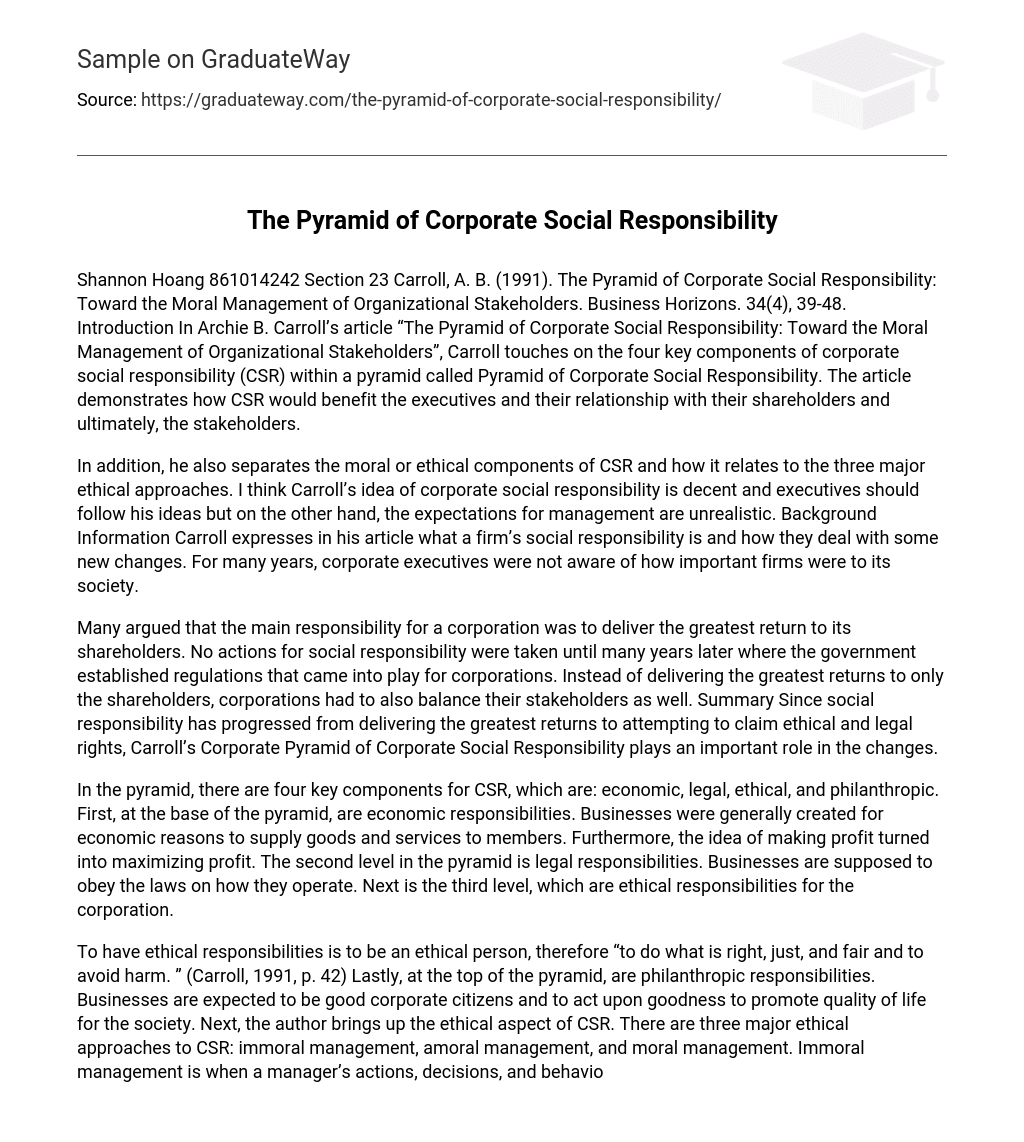Introduction
In Archie B. Carroll’s article “The Pyramid of Corporate Social Responsibility: Toward the Moral Management of Organizational Stakeholders”, Carroll touches on the four key components of corporate social responsibility (CSR) within a pyramid called Pyramid of Corporate Social Responsibility. The article demonstrates how CSR would benefit the executives and their relationship with their shareholders and ultimately, the stakeholders.
In addition, he also separates the moral or ethical components of CSR and how it relates to the three major ethical approaches. I think Carroll’s idea of corporate social responsibility is decent and executives should follow his ideas but on the other hand, the expectations for management are unrealistic. Background Information Carroll expresses in his article what a firm’s social responsibility is and how they deal with some new changes. For many years, corporate executives were not aware of how important firms were to its society.
Many argued that the main responsibility for a corporation was to deliver the greatest return to its shareholders. No actions for social responsibility were taken until many years later where the government established regulations that came into play for corporations. Instead of delivering the greatest returns to only the shareholders, corporations had to also balance their stakeholders as well. Summary Since social responsibility has progressed from delivering the greatest returns to attempting to claim ethical and legal rights, Carroll’s Corporate Pyramid of Corporate Social Responsibility plays an important role in the changes.
In the pyramid, there are four key components for CSR, which are: economic, legal, ethical, and philanthropic. First, at the base of the pyramid, are economic responsibilities. Businesses were generally created for economic reasons to supply goods and services to members. Furthermore, the idea of making profit turned into maximizing profit. The second level in the pyramid is legal responsibilities. Businesses are supposed to obey the laws on how they operate. Next is the third level, which are ethical responsibilities for the corporation.
To have ethical responsibilities is to be an ethical person, therefore “to do what is right, just, and fair and to avoid harm. ”Lastly, at the top of the pyramid, are philanthropic responsibilities. Businesses are expected to be good corporate citizens and to act upon goodness to promote quality of life for the society. Next, the author brings up the ethical aspect of CSR. There are three major ethical approaches to CSR: immoral management, amoral management, and moral management. Immoral management is when a manager’s actions, decisions, and behaviors oppose what is considered right or ethical.
Amoral management is when managers are classified in the middle, neither immoral nor moral. In addition, there are two types of amoral managers: unintentional and intentional. Unintentional managers are careless to their actions and they are unaware that their actions may be hurting those that they interact with on a business level. Intentional managers, on the other hand, believe that being ethical is appropriate to their personal life and not for business. As for moral management, “moral managers not only conform to accepted and high levels of professional conduct, they also commonly exemplify leadership on ethical issues.Furthermore, Carroll explains the stakeholders’ orientation toward the five stakeholder groups: owners (shareholders), employees, customers, local communities, and the society-at-large. It appears that immoral management is only concerned with their own self-interest for the executive groups and manipulating employees. Amoral management is good because they obey the laws toward the groups, but they do not care about their shareholders. Lastly, moral management thinks about the employee’s best interest and respect.
I believe that Carroll’s article proposed great ideas by taking economic, ethical, legal, and philanthropic responsibilities into consideration for corporate social responsibility. Managers play a vital role in a corporation to its stakeholders. Mangers have to take others into consideration and the article has listed many improvements, but it is unrealistic because there are managers that only care about themselves. I believe that corporations have the right to maximize their profits because that is their intention, but it does not necessarily mean that they cannot apply good social responsibilities.
Similarly, in the Pyramid of Corporate Social Responsibility, corporate executives have to remain profitable because they own a business and they also have to abide by the laws. Being ethical is a decision that a manager has to ultimately make. Participating in philanthropy may take up some time, but it is a beneficial factor because people love to cooperate with organizations that benefit the community. On the other hand, it is tough to attempt to achieve good social responsibility because most businessmen inhabit the quality of self-interest. Because the business landscape is replete with immoral and amoral managers, moral managers may sometimes be hard to find. ” I agree because it appears that managers only tend to care about themselves along with their gains that they tend to overlook their customers and even employees. Carroll mentioned, “Leadership by example is the most effective way to improve business ethics. I agree to a certain extent because the majority of people tend to be followers than leaders, and by seeing action taken by a moral manager, an immoral manager may take moral actions into consideration.
Moral management is the ideal model that managers should imitate but unfortunately, there are not many managers that follow this model. However, most managers are leaders therefore it may not be such an effective way to improve business ethics because they may already be setting a bad example. All in all, “if the “good society” is to become a realization, such a high expectation only naturally becomes the aspiration and preoccupation of management. ”





